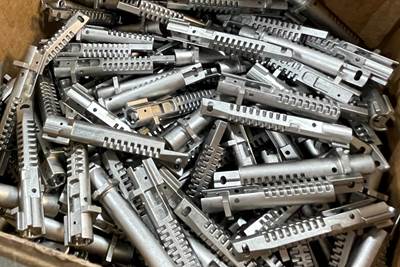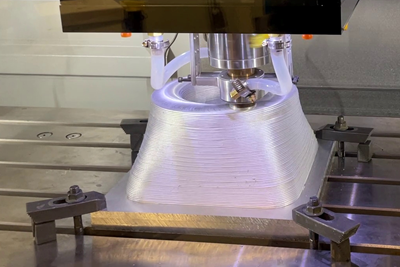Alpha Precision Group (APG) in Ridgway, Pennsylvania, has a history of manufacturing parts through powder metallurgy. Along with conventional techniques including press and sinter and metal injection molding (MIM), the company also uses a collection of metal 3D printing techniques including binder jetting, bound metal deposition (BMD) and now MoldJet to manufacture metal parts.
The MoldJet process developed by Tritone Technologies combines powder metallurgy with 3D printed wax molds used to form the green parts layer by layer. This video explores how this sinter-based additive manufacturing process works, and some of the use cases that APG is finding for this technology.
Transcript
I’m Stephanie Hendrixson with Additive Manufacturing Media. I'm learning about sinter-based additive manufacturing here at Alpha Precision Group, APG, in Ridgway, Pennsylvania.
This is a MIM company, a metal injection molding company that has adopted various types of metal 3D printing, including bound metal deposition, binder jetting, and this most recent addition. This is a MoldJet printer, the Dominant platform from Tritone Technologies.
This machine uses a carousel system with multiple different stations to accomplish higher volume 3D printing of green metal parts.
It starts with a wax build platform that is first leveled. Once it's flat, the build platform goes to the print station where four different printheads are precisely dropping wax to basically build up a stencil, a mold for the ultimate metal part. The stencil is built up in layers that are 130 microns high, and then they are machined down to be exactly 100 microns.
Then there is a slurry, a paste of metal powder with some additives that is flowed into the mold to start building up the structure of the parts.
From there, the build platform travels to one of two drying stations. There are two inside the machine so that you can be running up to six different build platforms at once without wasting any time. And then each layer is inspected before the whole process starts again.
Once the build is complete, the entire build platform goes into an oven where the wax is melted away. And then finally the brown metal parts go through a sintering furnace to achieve their final part properties.
The Tritone process results in isotropic shrinkage, so it's predictable and parts shrink evenly from all dimensions.
APG is finding this machine and this technology useful for a couple of different applications. They're doing a lot of things to bridge customers from 3D printing into MIM. So this is a way to test out geometries and to experiment with sintering conditions before cutting the tool and going to metal injection molding.
But it also makes sense for certain end use components as well, especially those with complicated geometries that would be difficult to mold or difficult to make with binder jetting and those with complicated internal features where it would be too challenging to remove the powder from inside.
Some of the end use parts that they're making with this system include components for firearms, other industrial applications and situations where quantities are maybe in the hundreds to the thousands, where it doesn't make economic sense to go to metal injection molding.
Related Content
3D Printing with Plastic Pellets – What You Need to Know
A few 3D printers today are capable of working directly with resin pellets for feedstock. That brings extreme flexibility in material options, but also requires greater knowledge of how to best process any given resin. Here’s how FGF machine maker JuggerBot 3D addresses both the printing technology and the process know-how.
Read MoreDMG MORI: Build Plate “Pucks” Cut Postprocessing Time by 80%
For spinal implants and other small 3D printed parts made through laser powder bed fusion, separate clampable units resting within the build plate provide for easy transfer to a CNC lathe.
Read MoreCasting With Complexity: How Casting Plus 3D Printing Combine the Strengths of Both
Aristo Cast is advancing a mode of part production in which casting makes the part, but 3D printing enables the geometry.
Read MoreWhat Does Additive Manufacturing Readiness Look Like?
The promise of distributed manufacturing is alluring, but to get there AM first needs to master scale production. GKN Additive’s Michigan facility illustrates what the journey might look like.
Read MoreRead Next
Binder Jetting Follows in Footsteps of Metal Injection Molding
For Smith Metal Products, additive manufacturing helps MIM customers finalize the design, but production opportunities are waiting.
Read MoreUnusual Forms of 3D Printing, and How to Categorize This Technology: AM Radio #21A
In this episode of AM Radio, Stephanie Hendrixson and Peter Zelinski quiz each other on six 3D printing processes — some common, some novel. Test your own knowledge and stick around for a discussion about how to categorize (or maybe re-categorize) AM technologies.
Read MoreSinter-Based Additive Manufacturing Finds a Place Alongside MIM, Press and Sinter at APG
Powder metallurgy company Alpha Precision Group (APG) is applying a particular class of metal 3D printing technology for both rapid iteration in development and flexibility in production.
Read More

.jpg;width=70;height=70;mode=crop)
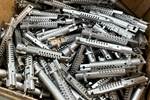
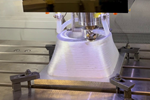
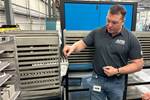







.png;maxWidth=300;quality=90)








